This Sourdough Sweet Potato Cinnamon Swirl Bread highlights the vibrant color and natural sweetness of roasted sweet potatoes. Their addition lends pillowy softness to each bite, while a salted maple glaze balances the sweetness of the loaf. Yeast streamlines baking, and sourdough brings a rich, tangy flavor. Every slice reveals a striking cinnamon swirl, making it an eye-catching choice for breakfast or brunch.

Sponsored by Bako Sweet®: I'm truly grateful for your support of the brands that help make Make It Dough possible. I want to assure you that all the recommendations and opinions expressed in this post are my own.
Jump to:
- Why Add Sweet Potatoes to Bread?
- Why I Love This Recipe
- Ingredients and Substitutions
- Baking with Sourdough Discard
- Can I make this recipe with active sourdough starter?
- How to Make Sweet Potato Sourdough Cinnamon Swirl Bread
- All About Gluten Development
- Guide to Fermentation Times
- Mixer Instructions
- Baker’s Tips
- Recipe FAQs
- You May Also Like
- Sweet Potato Sourdough Discard Cinnamon Swirl Bread
Why Add Sweet Potatoes to Bread?
Not only do sweet potatoes lend a vibrant orange hue to this delicious loaf, but they also bring a host of advantages. Water locked inside sweet potatoes adds moisture to the dough without making it too difficult to handle. Moreover, they play a role in limiting gluten formation, resulting in bread that’s pillowy soft and tender. Aside from flavor and texture, they also add a nutritious boost of potassium, fiber and vitamins C and A.

This recipe was developed using Bako Sweet® organic sweet potatoes! Their sweet potatoes are California-grown using sustainable farming practices that care for the land. They are meticulously hand-selected by seasoned farmers, tripled-washed, and conveniently bagged, ensuring they arrive at our tables in prime condition.
Love sweet potatoes? Check out my recipes for Sourdough Sweet Potato Biscuits and Sourdough Discard Sweet Potato Sandwich Bread.
Why I Love This Recipe
- Pillowy soft and sweet thanks to Bako Sweet® Organic Orange Sweet Potatoes.
- Show-stopping orange hue.
- Mixed by hand, no stand mixer required!
- Great way to use up excess sourdough discard.
- Delicious sourdough flavor with the convenience of commercial yeast.
Ingredients and Substitutions

Bako Sweet® Organic Orange Sweet Potatoes: This recipe uses one medium-sized sweet potato (about 300 grams). Roast the sweet potato at 400 F for 45 to 50 minutes and let it cool completely before starting the recipe. There’s no substitute for this ingredient.
All-purpose flour: The low protein content of all-purpose flour imparts a plush texture to this bread. You can substitute bread flour in a pinch but do not use whole wheat flour. Need help figuring out which flour to use in your recipes? Check out my post on, The Best Flour for Sourdough.
Active-dry yeast: You can also use instant yeast for this recipe, feel free to skip the blooming step if you choose you do so.
Sourdough discard: Both active starter and sourdough discard work for this recipe. If you don’t have a sourdough starter, add 75 grams flour and 75 grams water to your dough.
See recipe card for detailed ingredient information.
Baking with Sourdough Discard
Sourdough discard is any portion of your sourdough starter not used to make bread. Instead of throwing it away, you can use it to make other sourdough discard recipes like Sourdough Brownies, Sourdough Carrot Cake Muffins, and even Sourdough Pasta.
The addition of sourdough discard contributes a rich and nuanced flavor to this sweet dessert bread. Since the sourdough starter is used solely for flavor enhancement, there's no need to activate or feed it and you can use it directly from the refrigerator.

Can I make this recipe with active sourdough starter?
Absolutely! However, you'll need to adjust the fermentation time for the dough. Instead of a quick rise, the dough will take about 4 to 6 hours to double.
If you don’t want to use commercial yeast, simply replace the sourdough discard in the recipe with an equal amount of active sourdough starter.
How to Make Sweet Potato Sourdough Cinnamon Swirl Bread
STEP 1: Make the dough
Activate the yeast. Whisk sweet potatoes and sourdough discard into the yeast mixture. Fold the dry ingredients in. Knead the butter into the dough. Continue kneading until the dough looks smooth and feels supple.

All About Gluten Development
Your dough will appear bumpy and webby after the first round of kneading, this is a sign of gluten formation. Let the dough rest for 10 minutes to let the gluten network relax and strengthen, continue kneading for another 5 minutes until your dough looks smooth.
STEP 2: Bulk fermenation
Round the dough into a tight ball, transfer to a clean, lightly greased bowl and let it rise in a warm spot until doubled in volume, about 45 minutes to 1 hour.

Guide to Fermentation Times
Yeast becomes more sluggish in cold temperatures, therefore the conditions in your kitchen will greatly affect proofing times. I give time estimates in this recipe, but you may find that dough rises quicker in the summer and much slower in the winter. Be patient, not giving your dough enough time to rise will result in gummy, dense bread.
STEP 3: Add cinnamon filling
Flatten the dough out into a 12 by 18-inch rectangle. Sprinkle the cinnamon sugar topping evenly on top of the dough. Working with the longer side, roll the dough into a tight log.

STEP 4: Shape the dough
Split the log in half. Twist the dough so the cut side faces upward. Coil the dough to make a 2 strand braid. Transfer the dough to a parchment-lined baking sheet and shape it into a circle. Cover with plastic wrap and let the dough rise until puffy and well-risen, about 30 to 45 minutes.

STEP 5: Bake
Brush the dough with egg wash. Bake at 325 F for 40 to 45 minutes or until the center of the loaf measures at least 190 F when probed with an instant-read thermometer.

Mixer Instructions
- Combine the ingredients in the bowl of a stand mixer, use a paddle attachment to stir the ingredients together.
- Once the dough appears cohesive, switch to a dough hook and mix until the dough clings to the hook and away from pulls away from the sides of the bowl.
- Turn the dough out on a clean surface. Knead the dough for 1 to 2 minutes until smooth and pliable.
- Round the dough into a ball and place into a clean bowl.
- Then proceed with the recipe as instructed.
Baker’s Tips
- Weigh your ingredients. Measuring by weight is much more accurate than by volume (with tablespoons and cups).
- Commercial yeast has a shelf life. Make sure your yeast is not expired before attempting this recipe.
- Both sourdough discard and active sourdough starter will work for this recipe.
- Knead the dough until smooth. A strong gluten network will allow the dough to capture and retain carbon dioxide during the fermentation process. This results in tender, pillowy bread.
- The best way to check if bread is baked is with an instant-read thermometer; it should measure at least 190 F when probed in the center.

Recipe FAQs
Sourdough discard is any portion of your starter removed during the feeding process or any part not used to leaven sourdough bread. You can use it in other bakes and dishes or store it in the refrigerator.
Your yeast may have been expired, or your kitchen may have been too cold. Try proofing your dough in a warmer spot, such as your oven with the light on but turned off.
I don't usually warm my milk for this recipe, however, if you want the dough to rise quicker you can heat up your milk.
You May Also Like
Did this recipe rise to the occasion?
★★★★★
Please leave a star rating and a comment. Your feedback helps me create more delicious sourdough recipes. I read and truly appreciate every message.
Don't forget to PIN this recipe on Pinterest to save it for later!
Thank you for your support!

Sweet Potato Sourdough Discard Cinnamon Swirl Bread
This section may contain affiliate links
Ingredients
Dough
- 300 grams sweet potato 1 medium
- 170 grams whole milk
- 67 grams brown sugar
- 7 grams active-dry yeast 1 packet
- 150 grams sourdough starter
- 480 grams all-purpose flour
- 6 grams salt
- 28 grams butter
Filling
- 100 grams brown sugar
- 10 grams cinnamon
Topping
- 1 egg
Salted Maple Glaze
- 28 grams maple syrup
- 120 grams powdered sugar sifted to remove lumps
- 28 grams whole milk
Click US Customary to view volume measurements
Instructions
- Roast the sweet potato: Preheat the oven to 400 F. Clean and poke multiple holes into the sweet potato. Place the sweet potato on a foil-lined baking sheet and roast for 45 minutes, or until a knife easily slides into the center. Let the sweet potato cool completely before using.300 grams sweet potato
- Activate the yeast: Whisk yeast in milk and sugar in a large mixing bowl until bubbly (about 15 minutes).170 grams whole milk, 67 grams brown sugar, 7 grams active-dry yeast
- Make the dough: Mash the cooled sweet potato. Stir the sourdough discard and mashed sweet potato into the yeast mixture until fully incorporated.150 grams sourdough starter
- Add the flour and salt into the wet ingredients and mix until a shaggy dough forms. Working inside the mixing bowl, knead the dough until it looks cohesive.480 grams all-purpose flour, 6 grams salt
- Knead the butter into the dough. The dough will feel greasy at first but will gradually feel less sticky as it is absorbed.28 grams butter
- Knead the dough: Turn the dough out on a clean work surface. Knead the dough until smooth, about 5 to 10 minutes.
- Your dough will appear bumpy and webby after the first round of kneading, this is a sign of gluten formation. Return the dough to the bowl, cover with plastic wrap and let it rest for 10 minutes to let the gluten network relax and strengthen.
- Turn the dough out and continue kneading for another 5 minutes until it looks smooth. Round the dough into a tight ball and transfer it to a lightly greased bowl.
- Bulk ferment: Cover the bowl with plastic wrap and let the dough rise until doubled in volume, about 45 minutes to 1 hour (or longer depending on the temperature of your kitchen).
- Add the cinnamon sugar filling: Flatten the dough out into a 12 by 18-inch rectangle using a rolling pin. Sprinkle the cinnamon sugar topping evenly on top of the dough. Working with the longer side, roll the dough into a tight log.100 grams brown sugar, 10 grams cinnamon
- Shape the wreath: Split the log in half. Twist the dough so the cut side faces upward. Coil the dough to make a 2 strand braid. Transfer the dough to a parchment-lined baking sheet and shape it into a circle.
- Final proof: Cover the baking pan with plastic wrap and let the dough rise until puffy and almost touching, about 30 to 45 minutes.
- Prep: Preheat the oven to 325 F. Whisk the egg.1 egg
- Bake: Brush the dough with egg wash using a pastry brush. Bake for 40 to 45 minutes or until the center of the loaf measures at least 190 F when probed with an instant-read thermometer.
- Let the bread cool for 15 minutes topping or the glaze will melt off.
- Make the glaze: Combine the ingredients and whisk until the glaze is thick but still runny enough to drizzle.28 grams maple syrup, 120 grams powdered sugar, 28 grams whole milk
- Enjoy and store: Drizzle glaze on top of the cooled loaf. Slice and serve. This loaf is best enjoyed the day it’s baked but will keep well when stored in an airtight container at room temperature for up to 3 days.
Tips
These recipes were developed and tested using grams for precise measurements. To increase your chances of success, I recommend investing in a kitchen scale. I've included rough volume estimates (in tablespoons and cups), but they might not be totally accurate.
Remember all ovens are unique, these recipes were tested in my oven which runs cooler than others. You might need to lower the temperature if your bake appears to be browning too quickly. Monitor your bake closely and make adjustments if needed.
Notes
- Commercial yeast has a shelf life. Make sure your yeast is not expired before attempting this recipe.
- Both sourdough discard and active sourdough starter will work for this recipe.
- Knead the dough until smooth. A strong gluten network will allow the dough to capture and retain carbon dioxide during the fermentation process. This results in tender, pillowy bread.
- Give the dough enough time to rise or your loaf will end up gummy and dense.
- The best way to check if bread is baked is with an instant-read thermometer; it should measure at least 190 F when probed in the center.
Recipe Video
Nutrition
I am not a nutritionist or dietitian, any nutrition information provided is an estimate.

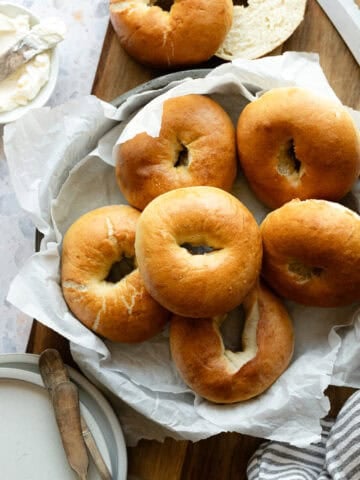
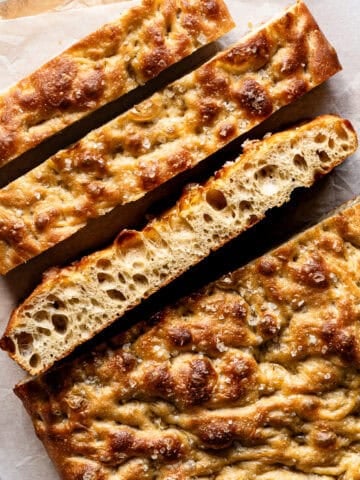
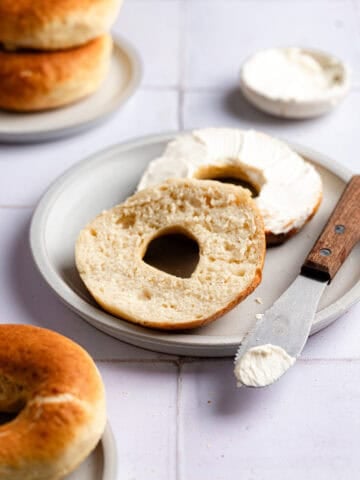
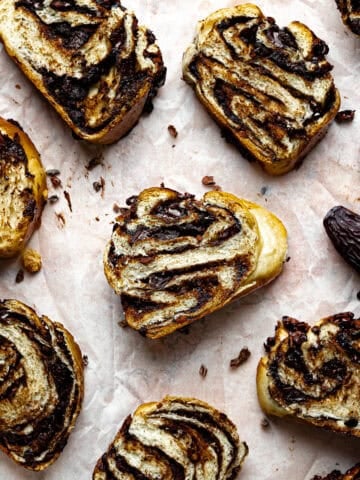
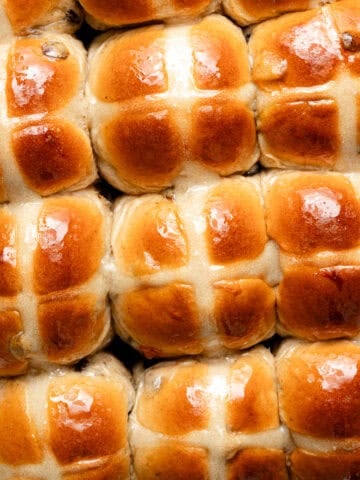
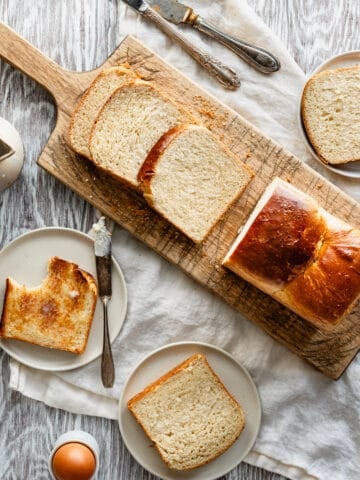

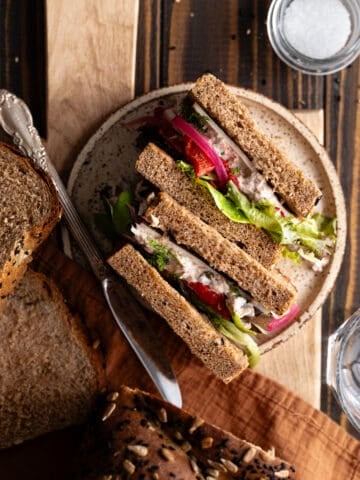
LALY says
Hello, don't you think it's a pity to use fresh yeast? wouldn't it be better to do a slow fermentation with the sourdough? thanks.
Hannah Dela Cruz says
You can totally do this with an active sourdough starter. Just adjust the fermentation times.
Yeast makes great bread as well and is a great option for beginners who are just trying to get the hang of bread baking. There are many other recipes on my site that don't use it